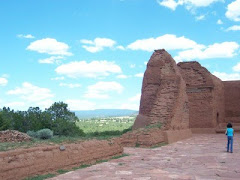
The 16 National Parks in New Mexico are treasures. Unfortunately, the administration's approach to the shining jewel that is our National Park system seems to be: deny funding, complain about resulting conditions, and threaten to privatize services. The results are cuts in law enforcement and less well-maintained parks.
Let's pause to respect the National Parks and the history they protect. Start by visiting them. Thus far in New Mexico, we're doing our best, with six to go. (Search this blog for national park entries.)
- Aztec Ruins National Monument: A pueblo built about A.D. 1100, a reconstructed great kiva.
- Bandelier National Monument : Archaeological sites in Frijoles Canyon, thousands of ancestral pueblo dwellings among its mesas and steep canyons.
- Capulin Volcano National Monument: Nearly perfect cinder cone formed from volcanic explosions 60,000 years ago. There are trails into the crater and around the rim.
- Carlsbad Caverns National Park: One of the world's largest underground chambers. More than 100 known caves and 33,125 acres of wilderness backcountry.
- Chaco Culture National Historical Park: Preserves the ruins of a major center of ancestral Puebloan culture, trade and administration dating between A.D. 850 and 1250. Also known for astronomical alignments and a complex road system.
- El Camino Real de Tierra Adentro National Historic Trail: Extending from the pueblo of Ohkay Owingeh in northern New Mexico to El Paso, Texas, the trail was the primary route between the colonial Spanish capital of Mexico City and Spanish provincial capitals, including Santa Fe.
- El Malpais National Monument and Conservation Area: 114,277 acres of volcanic features such as lava flows, cinder cones and lava tubes.
- El Morro National Monument: Sandstone bluff was a landmark for travelers because of a reliable water hole. Acestral Puebloans lived on the bluff more than 700 years ago.
- Fort Union National Monument: Ruins of a fort first established in 1851 to protect the Santa Fe Trail; you can see a network of ruts from the trail. T
- Gila Cliff Dwellings National Monument: Mogollon culture from 1280s until the early 1300s.
- Old Spanish National Historic Trail: From Abiquiu in northern New Mexico to Los Angeles marks a major 2,700-mile commercial trail founded in 1829.
- Pecos National Historic Park: 12,000 years of history including ancient pueblos, two Spanish colonial missions, Santa Fe Trail sites, 20th century ranching history and the site of the Civil War battle of Glorieta Pass.
- Petroglyph National Monument: Along 17 miles of a volcanic escarpment on Albuquerque's west mesa, the monument protects 25,000 images carved by native people and early Spanish settlers, hundreds of archaeological sites and five volcanic cones.
- Salinas Pueblo Missions National Monument: Ruins of 17th century mission churches at Quarai, Abo and Gran Quivira and a partially excavated pueblo.
- Santa Fe National Historic Trail: A commercial road through NM and four other states between 1821 and 1880; also was used by emigrants, military freight, gold prospectors, stagecoach lines and fur trappers.
- White Sands National Monument: Preserves dunes of white gypsum sand in 275 square miles of desert, and features desert plants and animals adapted to the environment.








